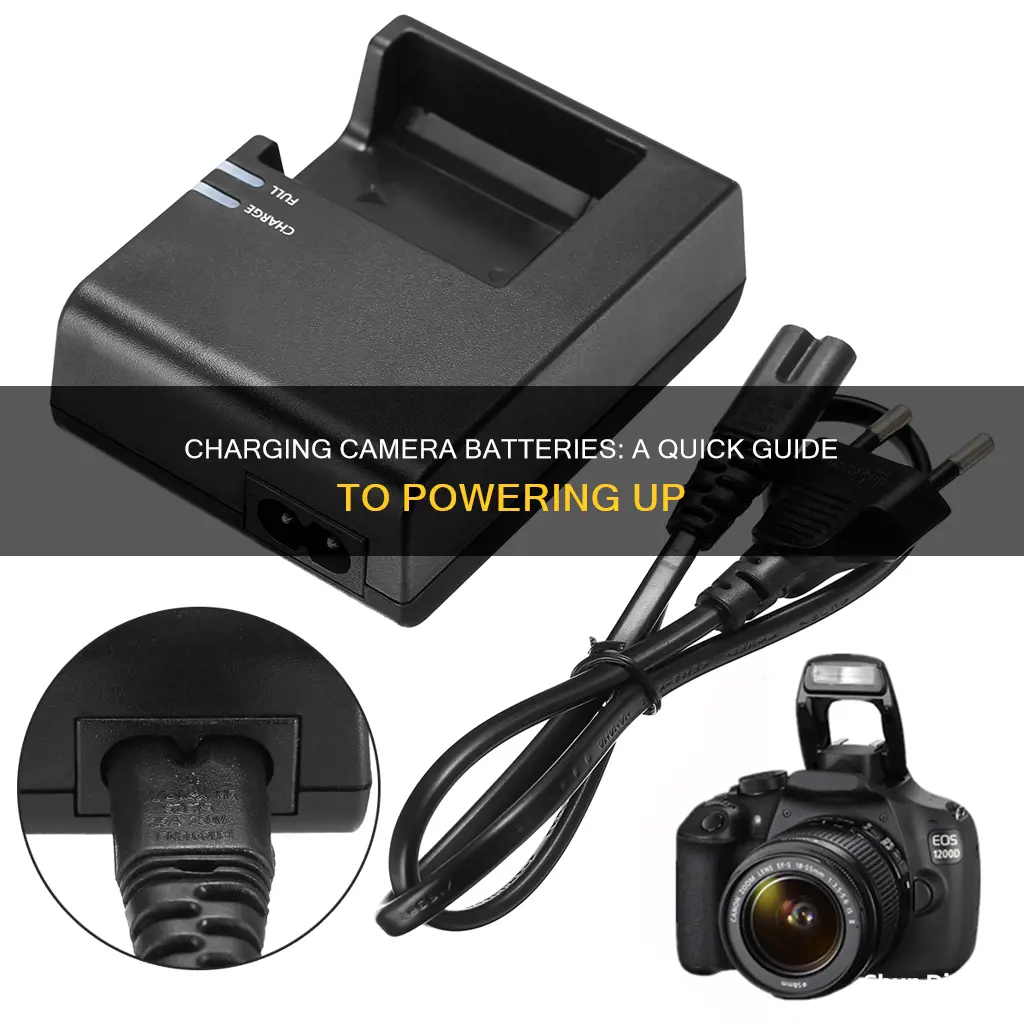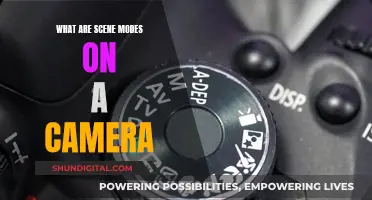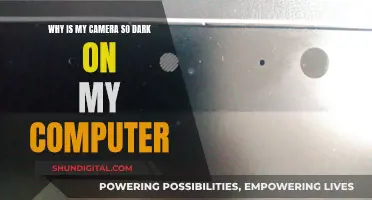
There are several ways to charge a camera, and the method you use will depend on the type of camera you have. Some cameras can be charged using a USB cable, either by connecting the camera to a power source, such as a power bank or a wall plug, or by connecting it to a computer. Other cameras may require a battery charger or come with an AC power adapter that can be plugged into an indoor power outlet. It's important to refer to the user manual for your specific camera model to ensure you're using the correct charging method and to take care of the camera battery and charger properly.
How to Charge a Camera
| Characteristics | Values |
|---|---|
| Charging device | USB cable and wall power net, power bank, computer |
| Charging port | USB-C or D-tap |
| Voltage | Depends on the camera. Too high or too low a voltage may damage equipment or lead to slow charging |
| Charging time | Depends on the camera. Could be around 4 hours 30 minutes |
What You'll Learn

Charging a camera with a USB cable
Firstly, it is important to note that not all cameras accept USB charging, so before attempting to charge your camera, check your camera's handbook or specifications. If your camera does support USB charging, you will need to ensure you have the correct USB cable and a reliable power supply.
If your camera requires an additional USB charging converter, you will need to purchase one that is compatible with your camera. Once you have the correct equipment, follow these steps:
- Turn off your camera.
- Insert the battery into the camera for charging.
- Attach the USB charging cable to the camera.
- Plug the other end of the USB cable into a power source. This could be a power adapter or the USB port of a computer.
- Charging will begin, and the USB charge lamp will light up.
- When charging is complete, the lamp will turn off.
It is important to note that you should not charge your camera continuously for more than 24 hours, and you should not leave it to charge overnight. Additionally, some cameras will not charge while the battery is inside, and you will need to use an external battery charger. Always refer to your camera's manual for specific instructions.
Charging Eufy Cameras: A Step-by-Step Guide
You may want to see also

Charging a camera with a power bank
Check Compatibility:
Before you begin, it's important to ensure that your camera battery is compatible with the power bank. Most power banks have standard USB ports, so you need to verify that your camera battery can be charged via USB. Check your camera's user manual or look for charging specifications, usually mentioned in volts (V) and amps (A). Make sure the power bank's output matches or is compatible with your camera battery's input requirements.
Gather the Necessary Equipment:
You will need a power bank with sufficient capacity to charge your camera battery. Additionally, you'll require a USB cable that is compatible with both the power bank and your camera. If your camera battery uses a unique connector, you may also need a USB adapter.
Connect the Power Bank:
Take the USB cable and plug one end into the power bank's USB port. If your power bank has multiple ports, choose the one with the highest output (usually indicated by numbers like 1A, 2.1A, etc.) for faster charging.
Connect the Camera:
Attach the other end of the USB cable to your camera's charging port. If your camera uses a proprietary connector, use the appropriate USB adapter to ensure a secure connection.
Start Charging:
Once the connections are secure, turn on the power bank. Your camera should start charging automatically. Some cameras may have LED indicators that show the charging status.
Monitor the Charging Process:
Keep an eye on both the power bank's battery level and the camera's charging progress. This is important to ensure that the power bank doesn't run out of power before your camera is fully charged.
Disconnect and Use:
Once your camera is fully charged, safely disconnect it from the power bank. You can now use your camera, and remember to store the power bank appropriately for future use.
It's important to note that charging times may vary depending on the capacity of both the power bank and the camera battery. Additionally, always refer to the user manuals of your camera and power bank for specific instructions and safety precautions.
Tips for Efficient Charging:
- Whenever possible, use a power bank with a higher capacity than your camera battery to ensure you can get multiple charges.
- Some power banks have built-in safety features that automatically stop charging when the camera battery is full, preventing overcharging and potential damage.
- Always use compatible cables and adapters to avoid damaging your equipment.
By following these steps and staying mindful of the specific requirements of your camera and power bank, you can effectively and safely charge your camera using a power bank.
Charging Your SimpliSafe Outdoor Camera: A Quick Guide
You may want to see also

Charging a camera with a computer
If your camera supports USB charging, you can follow these general steps:
- Turn off your camera.
- Use a micro USB cable to connect the camera to the USB terminal of the computer.
- Allow the camera battery to charge.
It is important to note that charging times may vary, and USB charging is generally slower than using a dedicated charger. Additionally, not all computers may be compatible with camera charging. If you are using a laptop, ensure it is connected to a power source, as USB charging can drain the laptop battery. Also, avoid turning on/off or restarting the computer, or waking it from sleep mode, while it is connected to the camera, as this may cause malfunctions.
Some cameras may require an additional USB charging converter, so it is always best to refer to the specific instructions provided by the camera manufacturer.
Charging the Noorio Camera: A Quick Guide
You may want to see also

Charging a camera with a plug adapter and AC power adapter
To charge a camera with a plug adapter and AC power adapter, follow these steps:
- Check your camera's power requirements: Before purchasing or using a power adapter, it is crucial to verify the power requirements of your camera. Different cameras have different power specifications, so ensure you have the correct information for your specific camera model.
- Choose a suitable power adapter: It is essential to select a power adapter that matches your camera's power requirements. Using an incorrect power adapter can damage your camera or the adapter itself.
- Attach the plug adapter to the AC power adapter: Ensure that the plug adapter is securely connected to the AC power adapter, following the instructions provided with your camera. Some cameras may have specific requirements for the orientation and insertion of the connectors.
- Connect the camera to the AC power adapter: Use the supplied USB cable or the built-in USB cable (if available) to connect your camera to the AC power adapter. Make sure the connectors are properly oriented and fully inserted.
- Plug the AC power adapter into an indoor power outlet: Once your camera is connected to the AC power adapter, plug the adapter into an indoor power outlet. This will provide power to your camera and initiate the charging process.
- Monitor the charging status: Refer to your camera's user manual to understand how to interpret the battery status icons or indicator lamps. This will help you track the charging progress and know when your camera is fully charged.
- Follow charging guidelines: Some cameras may have specific guidelines or restrictions regarding charging. For example, certain cameras may not charge while in shooting mode, or they may require regular cleaning of the battery terminals to ensure efficient charging. Always refer to your camera's manual for specific instructions.
Charging Kidamento Cameras: A Quick Guide
You may want to see also

Charging a camera with a compact power adapter
Charging a camera battery with a compact power adapter is a straightforward process. Here's a step-by-step guide:
- Prepare the Camera Battery: Ensure that you have the correct battery for your camera model. Some cameras may require you to insert the battery into the camera for charging, while others may have external charging ports.
- Power Off the Camera: It is crucial to turn off the camera before beginning the charging process. This is a safety measure and ensures that the charging can proceed smoothly.
- Connect the Compact Power Adapter: With the camera powered off, open the digital terminal cover. Take the included interface cable and insert the smaller plug into the camera terminal. The interface cable should have been provided with your camera.
- Attach the Power Adapter to a Power Source: Now, take the larger plug of the interface cable and connect it to the compact power adapter. Then, plug the power adapter into a power outlet. Ensure that the power outlet you're using is compatible with the adapter.
- Initiate Charging: Once everything is connected, charging should begin automatically. There is usually a charging lamp or indicator on the camera that lights up to confirm the charging process.
- Monitor the Charging Process: Keep an eye on the charging lamp or indicator. When the charging is complete, the lamp will turn off, indicating that your camera battery is fully charged and ready for use.
- Remove the Charger: Once the battery is fully charged, it is important to unplug the power adapter from the power outlet and the interface cable from the camera. This helps maintain the optimal condition of your battery.
- Avoid Overcharging: To protect your battery and keep it in top condition, avoid charging it continuously for more than 24 hours. Overcharging can shorten the battery life and affect its performance.
It is important to note that the specific steps may vary slightly depending on your camera model and the type of compact power adapter you are using. Always refer to your camera's user manual for detailed instructions specific to your device. Additionally, ensure that all connections are secure and that the power adapter and interface cable are compatible with your camera model.
Simplisafe Camera Battery: Charging Time Explained
You may want to see also







